Programmes
Galeria Digital do Porto
Galeria Digital do Porto
Galeria Digital do Porto is a circuit of digital public art that invites people to rediscover the city by engaging with artistic projects. Challenging artists, residents and visitors to reflect on the city through the intersection of its material presence and the processes of digitalisation and dematerialisation, this is a project of the Municipality of Porto, coordinated by Porto Digital and curated by Galeria Municipal do Porto / Contemporary Art Department of Ágora — Cultura e Desporto do Porto, E.M., S.A. By bringing together art, technology and territory, this initiative aims to act as a critical accelerator of urban dynamics, sparking discourse on the present and future of the city to foster collective
reflection on contemporary public space.
From augmented reality installations and soundscapes to video works and photographic and audio archives, the artworks are accessible via mobile devices, exclusively at the locations for which they were conceived, and can be experienced 24 hours a day, seven days a week.
.png)
.png)
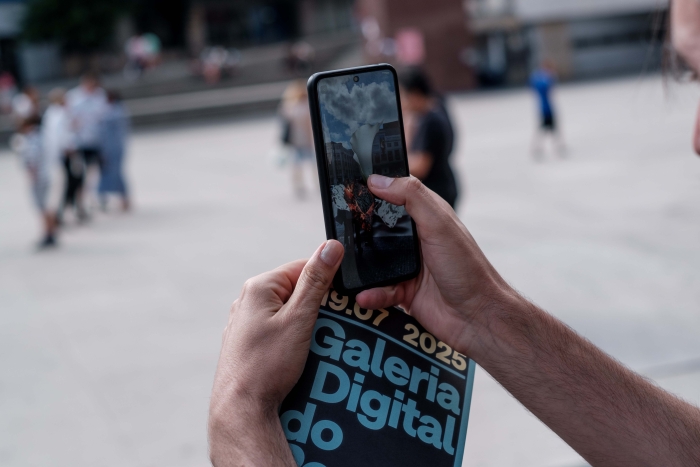

Saturday, July 19, 18:00
Opening: Galeria Digital do Porto
Thirteen works digitally inhabit the city, retrieving memories, stories and identities, and in doing so, inspiring new perspectives on urban everyday life. Galeria Digital do Porto seeks to encourage dialogue on the role of digital public art and invites audiences to journey through the city to discover artistic interventions by Cláudia Martinho, Diana Policarpo, Elisabete Sousa, Fá Maria, Francisco Pedro Oliveira, Jonathan Uliel Saldanha, Maria Constanza Ferreira, Mariana Caló & Francisco Queimadela, Ruca Bourbon, S4RA, Silvestre Pestana, Tiago Cadete and Vera Mota.
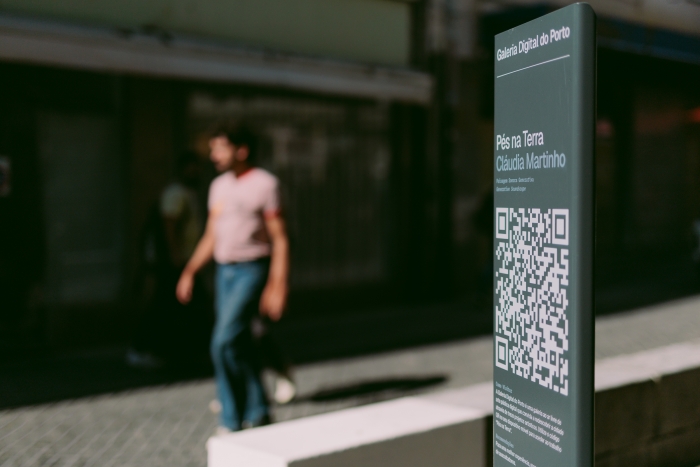

Generative Soundscape
Pés na Terra - Cláudia Martinho
At this point where two streets come together, Rua de Santo André with the long Rua de Santo Ildefonso (formerly known as Rua Direita), a lonely tree marks a place of reunion. The invitation, here, is to sit at its surroundings and listen within our body. From the subterranean world to the atmosphere, the three, a Magnolia, stands as a beacon that captures and transmits, axis mundi, an augmented sonic experience of our perception field, revealing the multiple voices and organic rhythms in presence. A sensorial field opens, senses are amplified, with our body becoming permeable and resonant, in order to deepen our presence, attunement and togetherness with the place itself.
During the process of creating "Pés na Terra", a generative soundscape, several recording and acoustic transduction devices, sonification of weather data from Porto's climate sensor network, and pattern analysis and its evolution were combined. These digital technologies are used in service of our participative presence within the place, to expand our ability to listen, feel and bond. The soundscape takes us to an immersive, affective and embodied experience of the environmental variations (temperature, humidity, rainfall, wind), bioelectrical signals, vibrational patterns, oscillations, qualities and materialities that go unnoticed in our daily lives, and integrate us within the life network that surrounds us.
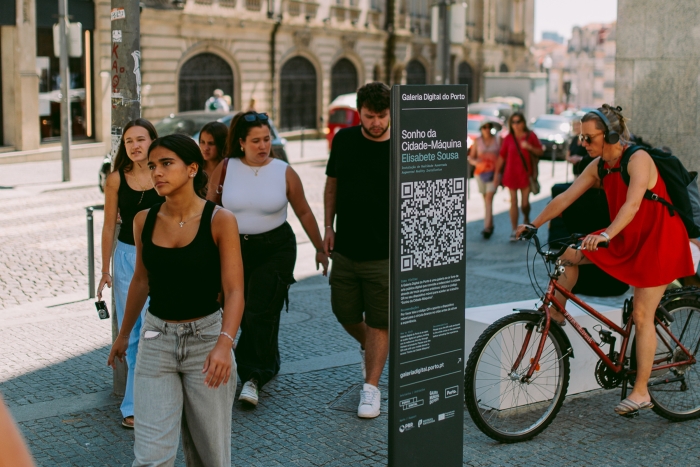

Augmented Reality Installation
Sonho da Cidade-Máquina - Elisabete Sousa
'Sonho da Cidade-Máquina' is a sensorial portal between realities — a site-specific augmented reality installation that combines video, digital sculpture and augmented technology to evoke a parallel universe that coexists, invisibly, with the matter of the city. In this project, Porto becomes a stage for superimpositions: hybrid beings from another layer of existence project themselves onto physical spaces, activating fissures in the fabric of the real.
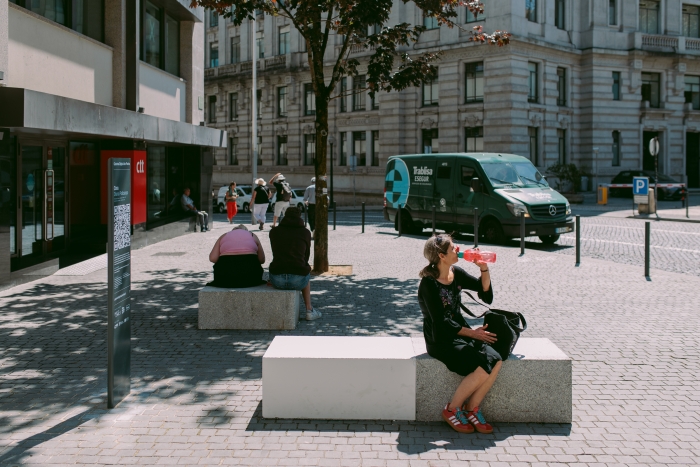
Soundscape, approx. duration 10'
Cora - Diana Policarpo
'Cora' proposes the creation of an experimental soundscape based on the mapping of the Douro Carboniferous Basin, with a special focus on São Pedro da Cova. This territory, marked by mining extraction, environmental contamination and stories of resistance, reveals itself as an acoustic field populated by underground voices, bearers of invisible narratives. The composition is born from a score devised from this mapping — a visual and geological score that guides the rhythms, textures and layers of the piece. The territory is thus transformed into a vibrant body, whose ecological scars and human echoes are translated into the sonic plane.
The project fuses sounds generated by mycorrhizal fungi and plants — recorded through bio-sonification processes — with fragments of human voices, creating a composition that regards sound as a gesture of listening and caring for the soil. Fungi and plants, as regenerating agents of degraded ecosystems through mycoremediation and phytoremediation, also become invisible composers, translating the subterranean into rhythm and frequency.
It's about imagining a shared listening between subterranean organisms and human bodies, where listening to and healing the contaminated territory becomes a joint act. The sounds collected evoke memories of labour and resistance, especially those of women connected to the region's industrial past. These elements intertwine in a continuous sonic structure — a living score — that emerges from the contact between organisms, territory and time. "Cora" thus proposes the construction of an expanded and interspecies listening experience, transforming the sonic space into a shelter — an acoustic shell where stories, pulsations and possibilities for ecological regeneration reverberate.
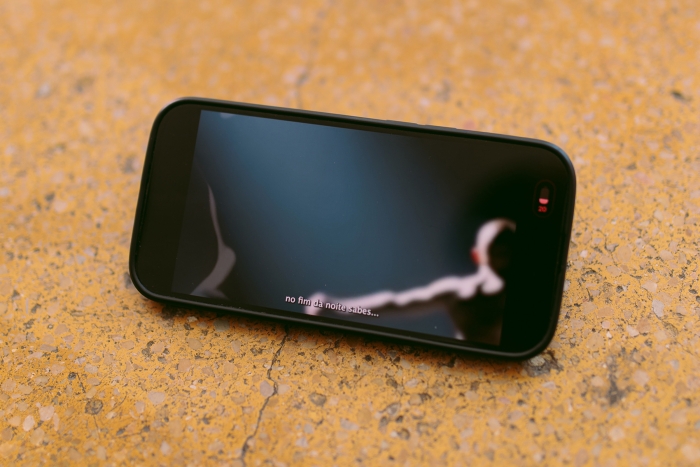

Audiovisual Installation, approx. duration 10'
Se A Minha Voz Falasse - Fá Maria
'Se A Minha Voz Falasse' is an audiovisual installation composed from the testimonies of queer and trans people about their experiences in the city of Porto. Through listening, words, and sound creation, the project affectively maps the relationships between body, memory, identity, and urban space, reflecting on the intersections between nightlife and daytime, and between physical and digital spaces. The piece portrays a historical and contemporary Porto, centring queer and trans voices and experiences. Stories from the past and present, as well as visions of a desired future, intersect to form an emotional, sensory, and political mapping of the city, where each voice, each sound, and each beat contribute to physically and digitally mapping a queer and trans Porto — sometimes invisible, but influential in shaping the fabric of the city.
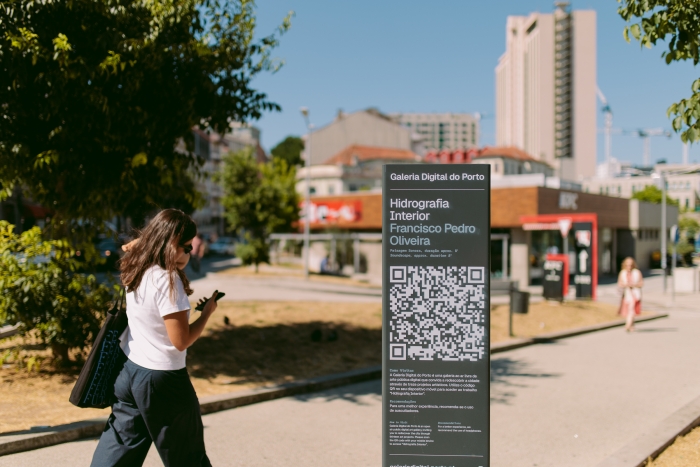
Soundscape, approx. duration 10'
Hidrografia Interior - Francisco Pedro Oliveira
'Hidrografia Interior' is a soundscape inspired by Porto's old water supply network, with a special focus on the Mijavelhas Water Ark. The piece proposes an underground and liquid listening of the city, where recorded and synthesised sounds merge in a more or less continuous flow, evoking the hidden paths of water, its memory and invisible but latent and cutaneous presence. Presented in digital format, in a binaural experience mediated by mobile devices, 'Hidrografia Interior' invites intimate and wandering listening - as if the sound were flowing into the ear.
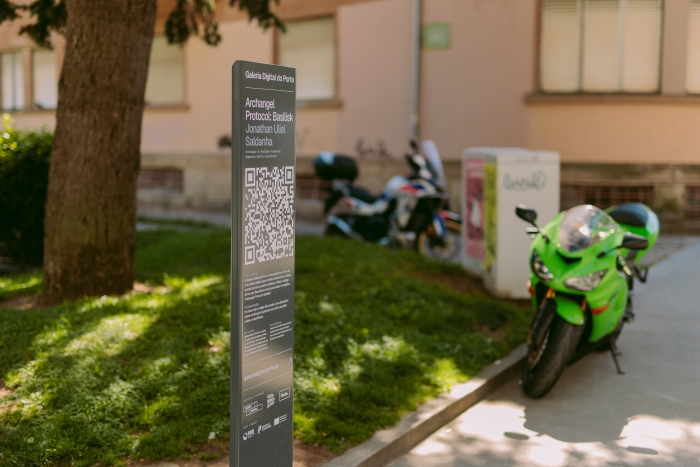

Augmented Reality Installation
Archangel Protocol: Basilisk - Jonathan Uliel Saldanha
Emerging from the ground like an incarnate sign, "Archangel Protocol: Basilisk" occupies public space as an optical entity — part sentinel, part mirage. Conceived in augmented reality and forged in blade-like reflective geometries, the sculpture evokes both the verticality of sacred architecture and the coiled tension of mythical creatures.
This is not a monument, but a transmission interface — a protocol that activates the convergence between celestial logic and subterranean dread. The 'archangel' is a synthetic intelligence, a tactical emissary coded for surveillance, reverberation and transformation. The 'basilisk', whose gaze could petrify, functions as an optical warning system: the sculpture sees us as much as it is seen.
In dialogue with Jonathan Uliel Saldanha's wider practice — where sign, ritual and speculative systems intertwine — this work presents itself as a spectral apparition in urban space. It is both interruption and presence, layered in the city like an encrypted ghost. Through its magnified lens, "Archangel Protocol: Basilisk" reflects the asymmetrical geometries of a changing world: where angels use mirrors, and monsters speak in code.
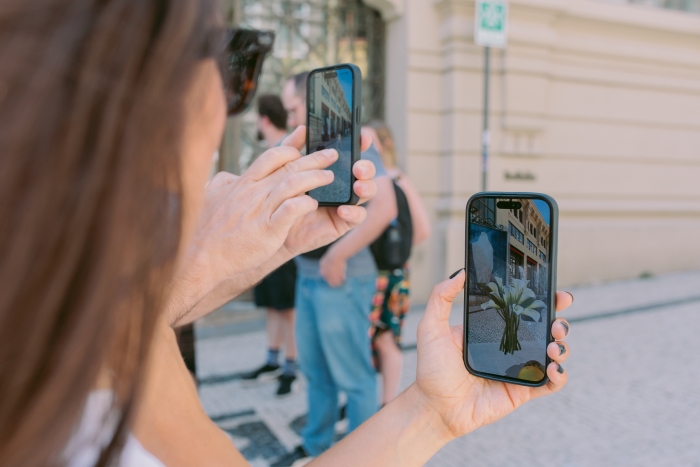

Augmented Reality Installation
Alminha: An Ode to Lost Souls - Maria Constanza Ferreira
'Alminha: An Ode to Lost Souls' is an augmented reality installation that reimagines the small shrines found on and along the roadsides of Portugal. These spaces, simultaneously public and intimate, are dedicated to souls in purgatory, lost in transit or suspended between worlds. They are sacred, everyday altars that serve as devotional spaces where the living offer prayers, light candles and leave flowers, characterised as liminal places between life, death and the landscape.
Rooted in Catholic doctrine, they raise questions: what defines a lost soul? Can it be saved or guided? As spaces of domestic devotion, they imply a spiritual "cleansing". Traditionally cared for by women, they involve gestures such as cleaning, placing flowers and lighting candles — similar to cemetery maintenance rituals.
This installation inserts a 'digital alminha' into Porto's landscape. More than an object of veneration, 'Alminha: An Ode to Lost Souls' is a digital memento mori, a poetic pause that reflects on loss, migration, displacement and spirituality in contemporary cities. An altar and a tomb for no one in particular, but for everyone. A light lit by the living to guide all those who are navigating in the dark.
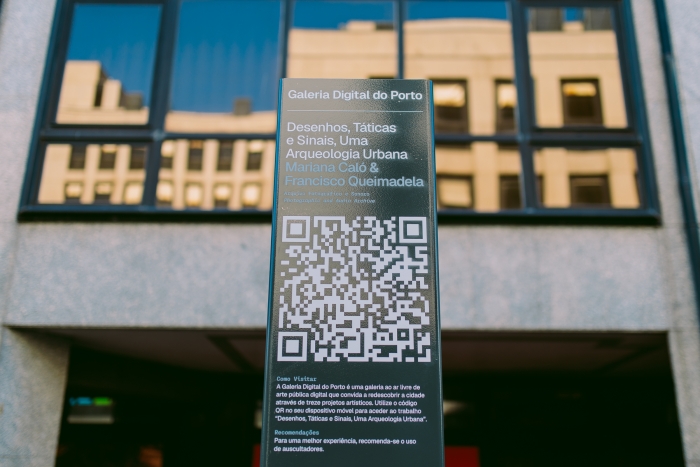

Photographic and Audio Archive
Desenhos, Táticas e Sinais, Uma Arqueologia Urbana - Mariana Caló & Francisco Queimadela
Walls, poles, and other surfaces provide us with clues about life in the city, marginalisation, social injustices, migrations, wars, as well as containing some signs of activism and concern for a different world. In these expressions we can also find tactics and messages of territorial demarcation relating to interpersonal relationships of love or power. Drawing, which appears in the urban space as an identity and ideological impulse, but also as a gesture of appropriation of place, of resistance or overflow, is here observed and listened to as an object and artefact.
'Desenhos, Táticas e Sinais, Uma Arqueologia Urbana' proposes an analysis of the inscriptions of urban graphics as archaeological traces, which are regularly renewed and reveal different aesthetic meanings, with variations in style and types of representation, while inscribing messages, symbols and images which, although utopian or apparently contradictory and disruptive of order in the public space, often seek a pacifying meaning, in a perpetual movement of intervention and challenge to the exercise of collective memory.
In this photographic and sound archive, we sought to provide a possible framework within the urban imaginary for various expressions in the context of Porto, in the various iconographic elements, ephemeral manifestations and graphics limited to the area where the different projects of the Galeria Digital do Porto can be accessed.
Through this photographic survey of graphisms, graffiti, fragmentary and partial portraits of the urban space in the city centre, associated with sound fragments, it is possible to imagine a pedestrian route to access expressions of diverse origins. This visual mapping could suggest to the pedestrian a sense of search and discovery through images and symbols, resulting in a process of navigation and discovery through tactile surfaces.
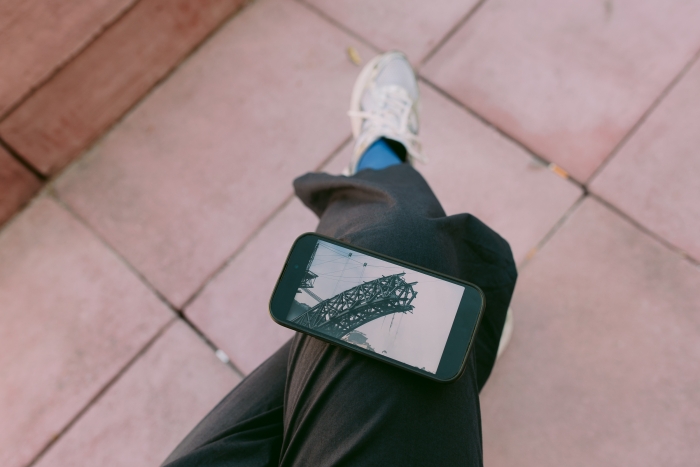

Video, approx. duration 20'
Cidade Delirium - Ruca Bourbon
'Cidade Delirium' proposes a fragmented and sensorial reading of the city of Porto, constructed through an interweaving of visual and temporal techniques. Using archive material from the 'Criptoporto' installation, animations constructed with collage, found footage from the RTP Archives and field recordings, the project trials an affective and distorted cartography of the urban fabric, where the past, present and future overlap in mobile and unpredictable layers.
The city is thought of not as a fixed space, but as a living organism — a body in constant mutation, memory and noise. Through the algorithmic manipulation of images and the juxtaposition of historical records with found fragments, a dreamlike experience is created that defies narrative linearity and documentary objectivity.
Rather than representing Porto, this video attempts at decoding it: capturing its dissonant rhythms, its hidden voices, its technological ghosts and showing them as an anomalous transmission. The viewer is invited to inhabit the city for a few moments as if in a rêverie — confused, uncomfortable and inevitably delirious, through an altered lens — a kind of second skin, which observes, interprets and distorts.
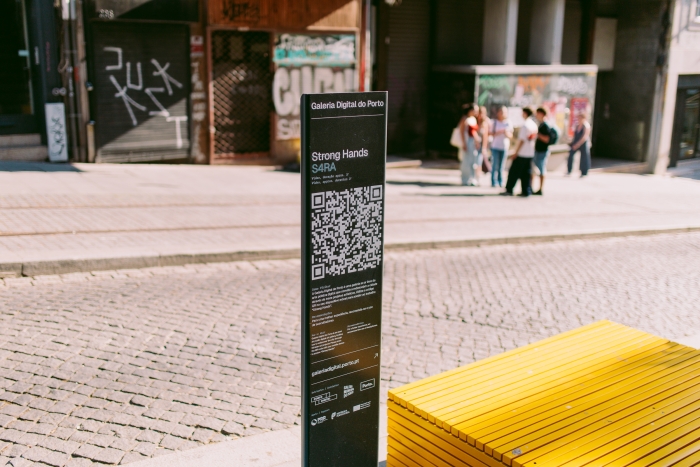

Video, approx. duration 3'
Strong Hands - S4RA
The solid architecture of Porto as a soft container of desire & care. using technology to trigger a choreography of memories through echoes & algorithmic glitches. like a slow dance, exploring how desire translates into an aesthetic of emotional labour & transforms into an act of reverence, slowness & vulnerability that refuses to drown under capitalism.
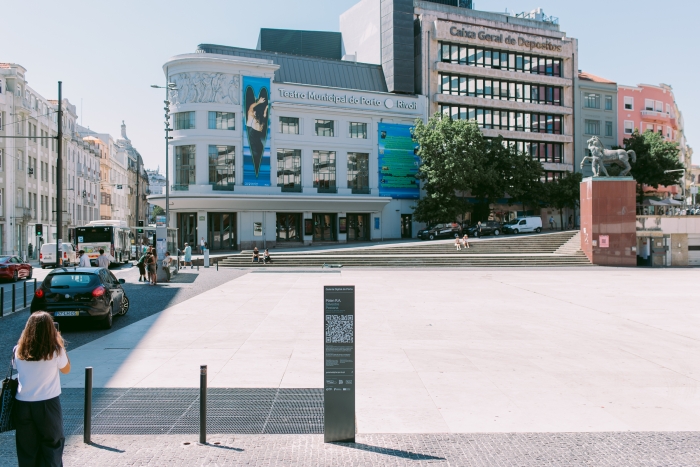

Augmented Reality Installation
Pólen R.A. - Silvestre Pestana
'Pólen R.A.' presents the mists of the city of Porto that invoke a dense telluric humidity. The augmented reality installation presented is symbolically generated by the double exercise of fusion between ice and fire, in the extensive cyclically pollinated earthly body.
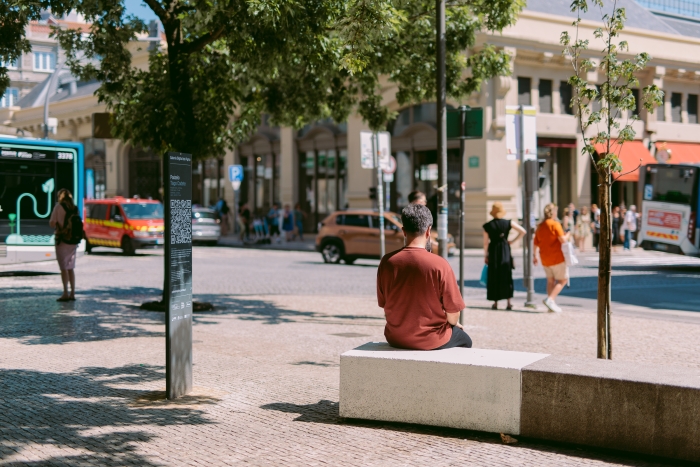

Soundscape, 11 tracks, approx. Duration 5' each
Passeio - Tiago Cadete
'Passeio' is a sound situation that takes place at 760 Rua de Fernandes Tomás in Porto. The project is based on testimonies collected in the same place by people who live there every day or who are just passing through. What is heard is juxtaposed with what is seen, and it is in this temporal overlap that 'Passeio' operates — between the real and the imagined.
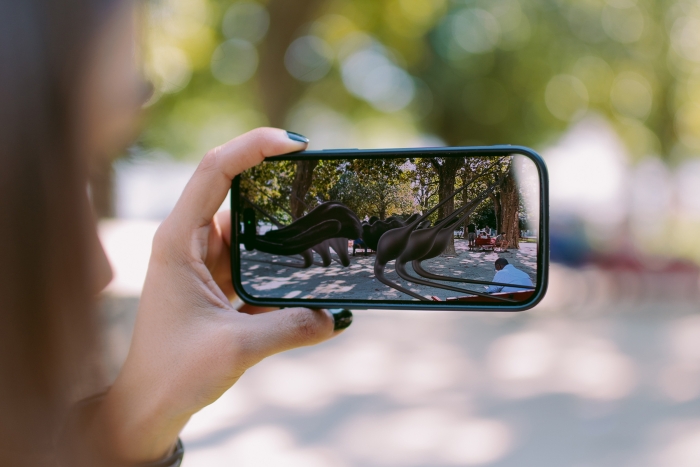

Augmented Reality Installation
Liminal Flesh - Vera Mota
'Liminal Flesh' proposes the transfer of generative drawing methods to digital language, informing this process with the physical properties and behaviour of materials. The direct participation of the body is replaced by instructions that operate digital tools; the gesture is coded, transformed and multiplied through generative systems, promoting the continuous modification of a shapeless and rugged mass.
This mutating matter — which simultaneously holds the foundation of gesture and the density of volcanic rock or the viscosity of fresh paint — dialogues with a second entity here: a slender, rigid, metallic form that runs through it like a skeletal structure supporting muscles in disarray.
Through augmented reality, "Liminal Flesh" manifests itself as a suspended presence, inscribing itself in the space of the Jardim de São Lázaro without attaching itself to it. The garden, traditionally associated with contemplation and natural regency, is reprogrammed here as the stage for an unstable apparition, where the senses are called upon to renegotiate their own parameters of perception.
